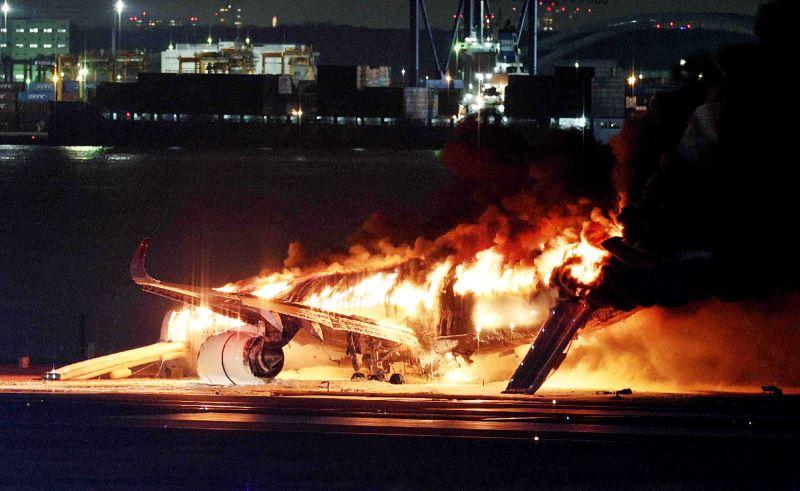This article is published in Aviation Daily, part of Aviation Week Intelligence Network (AWIN), and is complimentary through Jan 10, 2024. For information on becoming an AWIN Member to access more content like this, click here.

JAL Airbus A350-900, Tokyo Haneda Jan. 2, 2024
A Japan Airlines (JAL) Airbus A350-900 and a Japanese Coast Guard De Havilland Canada Dash 8 have been completely destroyed in a ground collision at Tokyo’s Haneda airport shortly after the JAL aircraft’s touch-down.
All 367 passengers and 12 crew members on board the A350 managed to escape the burning aircraft, but five of the six on board the Coast Guard aircraft have died. JAL said 13 passengers required medical attention. The airline also said the total passenger count included eight infants.
The accident is the first ever A350 hull-loss and Japan Airlines’ first accident since 1985.
JAL stated “[Flight] JL516 was involved in a collision with a Japan Coast Guard aircraft during its landing at Haneda Airport, resulting in a fire on the runway,” adding, “our thoughts and prayers are with the deceased members of the Japan Coast Guard. We want to assure you that all passengers and crew on our flight were safely evacuated.”
The carrier said it will “provide our full cooperation in the investigation of this unfortunate event.”
Airbus said, “In line with International Civil Aviation Organization (ICAO) Annex 13 recommendations, Airbus will provide technical assistance to the Bureau d’Enquêtes et d’Analyses (BEA) of France and to the Japan Transport Safety Board (JTSB) in charge of the investigation. For this purpose, Airbus is presently dispatching a team of specialists to assist the authorities.”
The aircraft manufacturer stated that “the exact circumstances of the event are still unknown.”
The A350 was operating flight JL516 from Sapporo with 367 passengers and 12 crew members and was landing at Haneda’s runway 34R at 5:47 p.m. local time, about 12 min. later than scheduled.
“The aircraft did not experience any issues or irregularities during its departure from New Chitose Airport or throughout the flight,” JAL said in a second statement. The A350’s pilots “acknowledged and repeated the landing permission from air traffic control, and then proceeded with the approach and landing procedures,” the airline added.
According to Flightradar24 data, the aircraft was crossing the runway threshold at a normal approach speed of 122 kt. and touched the ground shortly thereafter. Airport video footage shows how the aircraft was travelling down the initial part of the runway, when suddenly it appeared to hit an obstacle with large flames erupting. With its nose gear collapsed, the aircraft continued sliding down the runway and came to rest close to the end and to the right of it, not far from the airport perimeter fence on the edge of Tokyo Bay. A picture taken by one passenger shortly after having evacuated the aircraft, shows substantial impact damage to the nose of the aircraft and the nose gear missing.
The Coast Guard aircraft had reportedly loaded aid for support victims of Monday’s earthquake on the Noto Peninsula and was understood to be preparing to take off for a flight to Niigata Air Base.
Pictures of the A350 also show that escape slides had been deployed at the two front doors and the left rear door. Passengers appeared to not use the right rear door. While emergency services attempted to extinguish the fire, the aircraft ultimately burnt down completely.
“The aircraft’s announcement system malfunctioned during the evacuation, so cabin crew members conducted instructions using a megaphone and their voices,” JAL said. “Cabin crew members determined safe exits for evacuation, and all passengers and crew members evacuated through three emergency exits.”
According to the Aviation Week Network Fleet Discovery database, the aircraft registered JA13XJ (MSN 538) was delivered to JAL on Nov. 10, 2021. It had since accumulated 4,421 flight hrs. in 3,220 cycles. The aircraft was equipped in the high-density 367-seat configuration JAL has installed for domestic and short-haul flights. These include 12 seats in first, 94 in business and 263 in economy. The Coast Guard aircraft was a Dash 8-315Q registered JA722A. It has been delivered on Feb. 26, 2008. The aircraft had 7,573 hrs. and 2,700 cycles.
Haneda, one of Tokyo’s two international airports, stopped all take-offs or landings temporarily. According to Flightradar24, 110 flights scheduled to land at Haneda on the evening of Jan. 2 were either canceled or diverted to other airports including Tokyo-Narita.
Composite Structure Flammability
JL516 is the first A350 completely destroyed in an accident. The investigation could provide valuable insight into the flammability of large composite aircraft structures based on in-service experience that have so far been unavailable. In July 2013, an Ethiopian Airlines Boeing 787 suffered substantial, but much smaller, fire damage caused by a thermal runaway of the emergency locator transmitter (ELT) battery when on the ground at London Heathrow.
Flammability experts know composite-skinned airframes burn “inherently differently” than their aluminum counterparts, a 2012 U.S. Air Force Research Laboratory study on the subject noted. Aircraft composite material is a beneficial insulator that can help resist heat from nearby sources, such as an external fire, the study said. But those same properties make it difficult to cool down once it has heated up and present challenges for extinguishing parts of a fire that are hidden from firefighters.
Informal Boeing guidance on fighting composite aircraft fires issued after the 787 was introduced does not recommend “any major changes” from standard protocol.
“Extensive testing has been conducted in regards to combustibility and toxicity related to the composite structure,” the document, last updated in 2022, said. “This design not only adds to the strength of the product, but also makes it a good barrier to fire and heat. The structure does not aid in the spread of fire and acts as a barrier creating greater difficulty for an exterior fire to penetrate an intact fuselage. From a toxicity perspective, the composite structure during fire testing poses no greater hazard than an aluminum fuselage aircraft. Also, note that the burn through time on the composite structure is significantly longer than with the aluminum fuselage which may inherently provide greater safety to both the rescue fire responders and passengers in some scenarios.”
The accident will add to learnings from recent passenger evacuation and broader cabin safety improvement efforts. While the exact sequence of the evacuation will form part of the accident investigation, it is clear that all 389 people on board a densely configured widebody managed to escape the aircraft with only three of the four main slides being used.
JAL’s last hull-loss occurred on Aug 12, 1985, when a Boeing 747SR crashed into a mountain en route from Haneda to Osaka. The aircraft’s hydraulic systems ruptured after a violent failure of the rear pressure bulkhead. In one of the worst accidents in commercial aviation history, all 520 people on board died.
With Dan Williams in London, Chen Chuanren in Singapore and Sean Broderick in Washington.





